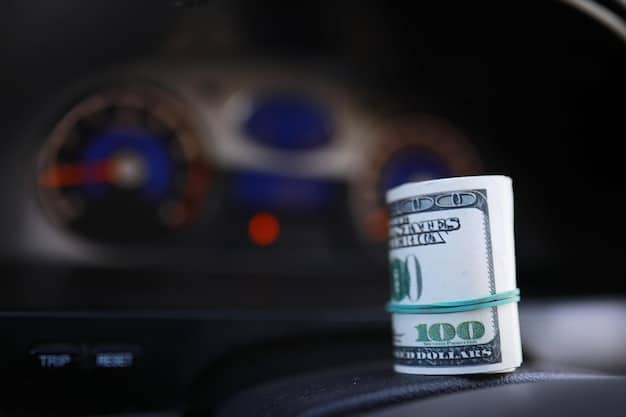Buying a Car with Cash in 2025: Smart Choice or Financial Folly?

Buying a car with cash in 2025 involves weighing factors like potential savings from avoiding interest, the opportunity cost of using a large sum of money, and car market dynamics, to determine if it aligns with one’s financial strategy.
Is buying a car with cash in 2025 the smartest move for your finances? While avoiding debt seems inherently wise, the evolving automotive market and broader economic factors require a closer look.
Is Paying Cash for a Car Still a Good Idea in 2025?
Deciding whether buying a car with cash in 2025 is a good idea hinges on several variables. From interest rates to investment opportunities, the financial landscape is constantly shifting. This section explores the immediate advantages and disadvantages of a cash purchase in this context.
The Allure of Avoiding Debt
One of the most compelling reasons to buy a car with cash is the elimination of interest payments. Over the life of a car loan, these charges can add up significantly, increasing the total cost of the vehicle.
Considering Opportunity Cost
However, paying cash means tying up a substantial amount of money. That capital could potentially be used for other investments, such as stocks, bonds, or real estate. This concept is known as opportunity cost.
- Assess potential investment returns.
- Factor in inflation.
- Evaluate personal risk tolerance.
Therefore, buying a car with cash presents a trade-off. It’s about comparing a guaranteed saving (interest) with a potential gain (investment returns).

Understanding the 2025 Car Market Landscape
The automotive industry is in constant flux, with electric vehicles (EVs), technological advancements, and supply chain dynamics influencing prices and availability. Understanding these factors is essential when considering buying a car with cash in 2025.
Electric Vehicles and Incentives
EVs are becoming increasingly popular, and governments often offer incentives, such as tax credits and rebates, to encourage their adoption. These incentives can significantly reduce the upfront cost of an EV.
Impact of Supply Chain Issues
Global supply chain disruptions have affected car production, leading to shortages and price increases. This situation might make negotiating a lower price more challenging, regardless of whether you’re paying cash or financing.
- Research available incentives.
- Monitor market trends.
- Consider pre-ordering or waiting for price stabilization.
In summary, the 2025 car market requires buyers to stay informed about EVs, incentives, and supply chain issues to make the smartest purchasing decisions, especially when buying a car with cash.
The Impact of Interest Rates on Car Loans in 2025
Interest rates play a pivotal role in determining the overall cost of a car loan. When evaluating whether to buy a car with cash in 2025, it’s essential to assess the prevailing interest rate environment. High interest rates could make a cash purchase more attractive.
Rising Interest Rates
If interest rates are trending upward, financing a vehicle becomes more expensive. This makes paying cash more compelling, as it eliminates the burden of these higher interest charges.
Comparing Loan Options
However, it’s also crucial to shop around and compare loan offers from different lenders. Credit unions, banks, and online lenders may offer varying rates and terms.
- Obtain quotes from multiple lenders.
- Consider a secured loan.
- Check your credit score.
In conclusion, understanding the interest rate landscape is paramount when deciding whether to buy a car with cash in 2025. High rates may tip the scales in favor of a cash purchase, but thorough research is always key.
Budgeting and Saving Strategies for a Cash Car Purchase
Buying a car with cash in 2025 necessitates careful budgeting and strategic saving. By establishing clear financial goals and implementing effective saving techniques, you can accumulate the necessary funds while maintaining overall financial well-being.
Creating a Savings Plan
Start by determining the target amount you need to save. Research the price range of the car you intend to purchase and factor in any associated costs, such as taxes and fees.
Cutting Expenses
Next, identify areas where you can reduce your spending. This might involve cutting back on discretionary expenses, negotiating lower rates on bills, or seeking ways to generate additional income.

Having a detailed budget and savings plan will pave the way for a successful cash purchase.
Negotiating a Better Deal When Paying Cash
Though dealerships do make money on financing, buying a car with cash in 2025 can be a powerful negotiating tool. In some instances, it might incentivize the dealer to offer a better price. Understanding the negotiating landscape and employing effective tactics can help you secure a favorable deal when paying upfront.
Leveraging Your Position
One potential advantage of paying cash is that it simplifies the transaction for the dealership. They avoid the complexities of dealing with lenders and potential financing delays, which might motivate them to lower the price.
Tactics for Success
Be prepared to negotiate assertively. Research the fair market value of the car you’re interested in and be willing to walk away if the dealer doesn’t meet your price expectations.
- Do your research.
- Get quotes from multiple dealerships.
- Be willing to walk away.
However be aware that some dealers will make more money on the financing, and may not offer as much of a discount on the car itself.
Alternative Options to Buying a Car Outright
While paying cash offers some benefits, it’s important to consider the alternatives. If used wisely, these strategies can enhance financial flexibility and mitigate the risks associated with tying up a large sum of money in a depreciating asset when considering buying a car in 2025.
Low-Interest Financing
Explore low-interest car loans as an alternative way to finance your purchase. If you can secure a low interest rate, the cost of borrowing might be less than the potential returns from investing your cash.
Leasing
Leasing a car involves making monthly payments for a specified period, typically two to three years. At the end of the lease term, you return the vehicle to the dealership.
- Consider low-interest financing.
- Explore leasing options.
- Weigh the pros and cons of each approach.
Choosing the optimal strategy depends on your needs, financial situation and preferences when buying a car in 2025.
| Key Point | Brief Description |
|---|---|
| 💰 Avoiding Interest | Paying cash eliminates loan interest, saving money over time. |
| 📈 Opportunity Cost | Cash could be invested for potential higher returns. |
| 🚗 Market Dynamics | EV incentives and supply chain issues impact car prices. |
| 🤝 Negotiation | Cash can be a strong negotiating tool with dealerships. |
Frequently Asked Questions (FAQ)
▼
Not always. It depends on interest rates, investment opportunities, and your financial situation. Low interest rates on loans might make financing more attractive than tying up a large sum of cash.
▼
Create a budget, track your expenses, and set clear savings goals. Reduce discretionary spending and explore ways to increase your income. Automate your savings contributions to make it easier.
▼
Major risk is tying up a large amount of money in a depreciating asset instead of investing it. It can also limit your financial flexibility in case of unexpected expenses or opportunities.
▼
It can give you an advantage. Dealerships avoid lender complexities, potentially offering better prices for cash buyers. Research car values and negotiate firmly.
▼
In most cases, no. Tax benefits are typically associated with specific incentives for electric vehicles or business use, not the payment method. Always check current regulations.
Conclusion
In conclusion, whether buying a car with cash in 2025 is the best financial decision depends on individual circumstances, prevailing market conditions, and personal financial goals. Carefully weighing the pros and cons, exploring alternative options, and developing a strategic approach are essential for making an informed choice.





